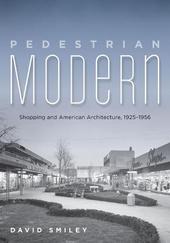
|
Pedestrian Modern: Shopping and American Architecture, 1925-1956
Paperback / softback
Main Details
| Title |
Pedestrian Modern: Shopping and American Architecture, 1925-1956
|
| Authors and Contributors |
By (author) David Smiley
|
| Physical Properties |
| Format:Paperback / softback | | Pages:352 | | Dimensions(mm): Height 254,Width 178 |
|
| Category/Genre | History of architecture |
|---|
| ISBN/Barcode |
9780816679300
|
| Classifications | Dewey:725.210973 725.2109730904 |
|---|
| Audience | |
|---|
|
Publishing Details |
| Publisher |
University of Minnesota Press
|
| Imprint |
University of Minnesota Press
|
| Publication Date |
10 July 2013 |
| Publication Country |
United States
|
Description
Too close to the wiles and calculations of consumption, stores and shopping centers are generally relegated to secondary, pedestrian status in the history of architecture. And yet, throughout the middle decades of the twentieth century, stores and shopping centers were an important locus of modernist architectural thought and practice. Under the mantle of modernism, the merchandising problems and possibilities of main streets, cities, and suburbs became legitimate-if also conflicted-responsibilities of the architectural profession. In Pedestrian Modern, David Smiley reveals how the design for places of consumption informed emerging modernist tenets. The architect was viewed as a coordinator and a site planner-modernist tropes particularly well suited to merchandising. Smiley follows this development from the twenties and thirties, when glass and transparency were equated with modernist rationality; to the forties, when cities and congestion presented considerable hurdles for shopping district design and, at the same time, when modern concerns about the pedestrian deeply affected city and neighborhood planning; to the early fifties, when both urban shopping districts and suburban shopping centers became large-scale modernist undertakings. Although interpreting the tools and principles of modernism, designs for shopping never quite shed the specter of consumption. Tracing the history of architecture's relationship with retail environments during a time of significant transformation in urban centers and in open suburban landscapes, Smiley expands and qualifies the making of American modernism.
Author Biography
David Smiley teaches at the Graduate School of Architecture, Planning and Preservation at Columbia University.
|